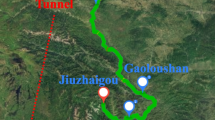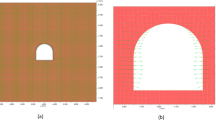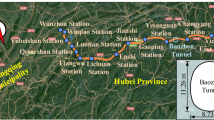Abstract
The complex mechanical behaviours of steeply inclined and layered surrounding rock in strong and active fault zones result in control measures that cannot adapt to asymmetric squeezing tunnel and are still unsolved. Hence, the Yuntunbao Tunnel was taken as an example to study this issue based on geological survey and indoor and outdoor tests. The results showed that strong geological structures and abundant groundwater undoubtedly deteriorate the mechanical properties of rocks containing many water-sensitive minerals, approximately 45%. The stepwise growth of deformation characteristics before reaching the rock peak strength and the gradient to abrupt failure characteristics after reaching the rock peak strength are determined via triaxial cyclic and static load tests. According to field test results, the unilateral squeezing deformation is severe and greater than 1.5 m, the average extent of the excavation loosening zone is approximately 10 m, and the highest deformation rate reaches 12 cm/d. The gradual and sudden changes in tunnel deformation are demonstrated to be consistent with the postpeak deformation characteristics of layered rock in indoor tests. Moreover, the steel arch exhibits composite failure characteristics of bending and torsion. Finally, reliable and practical controlling measures are suggested, including the optimised three-bench excavation method with reserved core soil, advanced parallel pilot tunnel, long and short rock bolts, and large lock-foot anchor pipe. Compared with tunnel deformation before taking measures, the maximum convergence deformation is reduced from 2.7 to 0.9 m, and the bearing force of the primary support is also reasonable and stable.
























Similar content being viewed by others
References
Meng LB, Li TB, Jiang Y, Wang R, Li YR (2013) Characteristics and mechanisms of large deformation in the zhegu mountain tunnel on the sichuan-tibet highway. Tunn Undergr Space Technol 37:157–164. https://doi.org/10.1016/j.tust.2013.03.009
Zhu HH, Yan JX, Liang WH (2019) Challenges and development prospects of ultra-long and ultra-deep mountain tunnels. Engineering 5(03):76–95. https://doi.org/10.1016/j.eng.2019.04.009
Tao ZG, Ren SL, Li G, Xu HT, Luo SL, He MC (2021) Model test on support scheme for carbonaceous slate tunnel in high geostress zone at high depth. J Mt Sci 18(3):764–778. https://doi.org/10.1007/s11629-020-6509-1
Tan ZS, Li ST, Yang Y, Wang JJ (2022) Large deformation characteristics and controlling measures of steeply inclined and layered soft rock of tunnels in plate suture zones. Eng Fail Anal 131:105831. https://doi.org/10.1016/j.engfailanal.2021.105831
Hoek E, Guevara R (2009) Overcoming squeezing in the Yacambú-Quibor Tunnel, Venezuela. Rock Mech Rock Eng 42:389–418. https://doi.org/10.1007/s00603-009-0175-5
Zhou ZH, Chen ZQ, He C, Kou H (2021) Investigation on the evolution characteristics and transfer mechanism of surrounding rock pressure for a hard-rock tunnel under high geo-stress: case study on the Erlang Mountain Tunnel, China. Bull Eng Geol Env 80:8339–8361. https://doi.org/10.1007/s10064-021-02439-4
Bian K, Liu J, Liu ZP, Liu SG, Ai F, Zheng XQ, Ni SH, Zhang W (2019) Mechanisms of large deformation in soft rock tunnels: a case study of Huangjiazhai Tunnel. Bull Eng Geol Environ 78:431–444. https://doi.org/10.1007/s10064-017-1155-8
Cao CY, Shi CH, Lei MF, Yang WC, Liu JW (2018) Squeezing failure of tunnels: a case study. Tunn Undergr Space Technol 77:188–203. https://doi.org/10.1016/j.tust.2018.04.007
Deng HS, Fu HL, Shi Y, Zhao YY, Hou WZ (2022) Countermeasures against large deformation of deep-buried soft rock tunnels in areas with high geostress: a case study. Tunn Undergr Sp Tech 119:104238. https://doi.org/10.1016/j.tust.2021.104238
Tian Y, Shu XY, Tian HM, He LK, Jin Y, Huang M (2023) Effect of horizontal stress on the mesoscopic deformation and failure mechanism of layered surrounding rock masses in tunnels. Eng Fail Anal 148:107226. https://doi.org/10.1016/j.engfailanal.2023.107226
Li G, Sun QH, Ma FS, Guo J, Zhao HJ, Wu YF (2023) Damage evolution mechanism and deformation failure properties of a roadway in deep inclined rock strata. Eng Fail Anal 143:106820. https://doi.org/10.1016/j.engfailanal.2022.106820
Man JH, Zhou ML, Zhang DM, Huang HW, Chen JY (2022) Face stability analysis of circular tunnels in layered rock masses using the upper bound theorem. J Rock Mech Geotech Eng 14(6):1836–1871. https://doi.org/10.1016/j.jrmge.2021.12.023
Zhou YY, Xu DP, Gu GK, Liu K, Wan LP, Wang TL, Yang JB (2019) The failure mechanism and construction practice of large underground caverns in steeply dipping layered rock masses. Eng Geol 250:45–64. https://doi.org/10.1016/j.enggeo.2019.01.006
Liu XZ, Liu F, Song KZ (2022) Mechanism analysis of tunnel collapse in a soft-hard interbedded surrounding rock mass: a case study of the Yangshan Tunnel in China. Eng Fail Anal 138:106304. https://doi.org/10.1016/j.engfailanal.2022.106304
Lu J, Yin GZ, Zhang DM, Gao H, Li CB, Li MH (2020) True triaxial strength and failure characteristics of cubic coal and sandstone under different loading paths. Int J Rock Mech Min Sci 135:104439. https://doi.org/10.1016/j.ijrmms.2020.104439
Wang PT, Ma C, Liu C, Liu QR, Fu YL, Cai MF (2023) Anisotropic behavior of excavated layered rock mass subjected to compression considering the joint roughness. Bull Eng Geol Env 82:373. https://doi.org/10.1007/s10064-023-03400-3
Jiang HP, Jiang AN, Yang XR, Zhang FR (2022) Experimental investigation and statistical damage constitutive model on layered slate under thermal-mechanical condition. Nat Resour Res 31(1):443–461. https://doi.org/10.1007/s11053-021-09974-7
Xu GW, He C, Yan J, Ma GY (2019) A new transversely isotropic nonlinear creep model for layered phyllite and its application. Bull Eng Geol Environ 78:5387–5408. https://doi.org/10.1007/s10064-019-01462-w
Yang SQ, Cheng L (2011) Non-stationary and nonlinear visco-elastic shear creep model for shale. Int J Rock Mech Sci 48(6):1011–1020. https://doi.org/10.1016/j.ijrmms.2011.06.007
Moussaei N, Sharifzadeh M, Sahriar K, Khosravi MH (2019) A new classification of failure mechanisms at tunnels in stratified rock masses through physical and numerical modeling. Tunn Undergr Space Technol 91:1–12. https://doi.org/10.1016/j.tust.2019.103017
Zhang L, Niu FJ, Liu MH, Ju X, Wang ZW (2022) Fracture characteristics and anisotropic strength criterion of bedded sandstone. Front Earth Sc-Switz 10:1–10. https://doi.org/10.3389/feart.2022.879332
Yang TJ, Wang PY, Wang SH, Liu H, Zhang Z (2023) Experimental study on shear-seepage coupling characteristics of single fractured rock mass under cyclic loading and unloading. Rock Mech Rock Eng 56(3):2137–2156. https://doi.org/10.1007/s00603-022-03125-x
Lin H, Liu JF, Yang JX, Ran LN, Ding GS, Wu ZD, LYU C, Bian Y (2022) Analysis of damage characteristics and energy evolution of salt rock under triaxial cyclic loading and unloading. J Energy Storage 56:106145. https://doi.org/10.1016/j.est.2022.106145
Zhang JB, Du RH, Chen YL, Huang Z (2023) Experimental investigation of the mechanical properties and energy evolution of layered phyllite under uniaxial multilevel cyclic loading. Rock Mech Rock Eng 56(6):4153–4168. https://doi.org/10.1007/s00603-023-03279-2
Peng K, Zhou JQ, Zou QL, Zhang YJ, Tan GW (2020) Deformation characteristics and failure modes of sandstones under discontinuous multi-level cyclic loads. Powder Technol 373:599–613. https://doi.org/10.1016/j.powtec.2020.06.076
Hu HR, Lu YY, Xia BW, Luo YF, Peng JJ, Li Y (2022) Damage characteristics of sandstone with different crack angles subjected to true triaxial cyclic loading and unloading. Theoret Appl Fract Mech 121:103444. https://doi.org/10.1016/j.tafmec.2022.103444
Hu B, Yang SQ, Xu P, Cheng JL (2019) Cyclic loading-unloading creep behavior of composite layered specimens. Acta Geophys 67:449–464. https://doi.org/10.1007/s11600-019-00261-x
Zhu WC, Li SH, Li S, Niu LL (2019) Influence of dynamic disturbance on the creep of sandstone: an experimental study. Rock Mech Rock Eng 52:1023–1039. https://doi.org/10.1007/s00603-018-1642-7
Tang LM, Zhao YL, Liao J, Liu Q (2020) Creep experimental study of rocks containing weak interlayer under multilevel loading and unloading cycles. Front Earth Sci 8:519461. https://doi.org/10.3389/feart.2020.519461
Guan K, Zhu WC, Liu XG, Wei J, Niu LL (2020) Re-profiling of a squeezing tunnel considering the post-peak behavior of rock mass. Int J Rock Mech Min Sci 125:104153. https://doi.org/10.1016/j.ijrmms.2019.104153
Sun ZY, Zhang DL, Li MY, Guo FL (2024) Large deformation characteristics and the countermeasures of a deep-buried tunnel in layered shale under groundwater. Tunn Undergr Space Technol 144:105575. https://doi.org/10.1016/j.tust.2023.105575
Li ST, Tan ZS, Yang Y (2020) Mechanical analyses and controlling measures for large deformations of inclined and laminar stratum during tunnelling. Geotech Geol Eng 38:3095–3112. https://doi.org/10.1007/s10706-020-01210-y
Xu GW, He C, Wang J, Chen ZQ (2020) Study on the mechanical behavior of a secondary tunnel lining with a yielding layer in transversely isotropic rock stratum. Rock Mech Rock Eng 53:2957–2979. https://doi.org/10.1007/s00603-020-02107-1
Liu WW, Chen JX, Chen LJ, Luo YB, Shi Z, Wu YF (2021) Deformation evolution and failure mechanism of monoclinic and soft-hard interbedded strata: study of muzhailing tunnel. J Perform Constr Facil 35(5):04021042. https://doi.org/10.1061/(ASCE)CF.1943-5509.0001605
Chen ZQ, He C, Ma XuGW, GY, Wang WB (2019) Supporting mechanism and mechanical behavior of a double primary support method for tunnels in broken phyllite under high geo-stress: a case study. Bull Eng Geol Env 78(7):5253–5267. https://doi.org/10.1007/s10064-019-01479-1
Liu WW, Chen JX, Chen LYB, LJ, Shi Z, Wu YF (2021) Deformation behaviors and mechanical mechanisms of double primary linings for large-span tunnels in squeezing rock: a case study. Rock Mech Rock Eng 54:2291–2310. https://doi.org/10.1007/s00603-021-02402-5
Zhao JP, Tan ZS, Li L, Wang XY (2023) Supporting structure failure caused by the squeezing tunnel creep and its reinforcement measure. J Mt Sci 20(6):1774–1789. https://doi.org/10.1007/s11629-022-7853-0
Yang K, Yan QX, Shi ZD, Zhang C, Ma SQ (2023) Numerical study on the mechanical behavior of shotcrete lining with yielding support in large deformation tunnel. Rock Mech Rock Eng 56:1563–1584. https://doi.org/10.1007/s00603-022-03126-w
Petraroia DN, Plückelmann S, Mark P, Breitenbücher R (2024) Tunnel lining segments with enhanced bearing capacity using hybrid concrete concepts. Tunn Undergr Space Technol 143:105484. https://doi.org/10.1016/j.tust.2023.105484
Zhou P, Jiang YF, Zhou FC, Gong L, Qiu WG, Yu JW (2022) Stability evaluation method and support structure optimization of weak and fractured slate tunnel. Rock Mech Rock Eng 55:6425–6444. https://doi.org/10.1007/s00603-022-02974-w
Tao ZG, Zhao F, Wang HJ, Zhang HJ, Peng YY (2017) Innovative constant resistance large deformation bolt for rock support in high stressed rock mass. Arab J Geosci 10:341. https://doi.org/10.1007/s12517-017-3127-5
Zhang JP, Liu LM, Liu CX, Li Y (2022) Mechanism and application of new prestressed yield bolt for controlling deep high-stress rock mass. Tunn Undergr Space Technol 119:104254. https://doi.org/10.1016/j.tust.2021.104254
Sun XM, Zhu MQ, Zhang Y, Zhao CW, Miao CY, Zhang SK (2022) Highly prestressed NPR cable coupling support technology and its application in the deep roadway. Eng Fail Anal 142:106707. https://doi.org/10.1016/j.engfailanal.2022.106707
LI Q, Tan K, Wang DZ, Zhao B, Zhang R, Li Y, Qi YJ (2018) Joint inversion of GNSS and teleseismic data for the rupture process of the 2017 Mw6.5 Jiuzhaigou, China, earthquake. J Seismol 22(3): 805–814. https://doi.org/10.1007/s10950-018-9733-1
Xu X, Gao R, Guo XY, Li WH, Li HQ, Wang HY, Huang XF (2017) Outlining tectonic inheritance and construction of the Min Shan region, eastern Tibet, using crustal geometry. Sci Rep 7(1):13798. https://doi.org/10.1038/s41598-017-14354-4
Zhao DZ, Qu CY, Shan XJ, Gong WY, Zhang YF, Zhang GH (2018) InSAR and GPS derived coseismic deformation and fault model of the 2017 Ms7.0 Jiuzhaigou earthquake in the Northeast Bayanhar block. Tectonophysics 726:86–99. https://doi.org/10.1016/j.tecto.2018.01.026
Zhao YC, Ye GF, Dong JE, Wei WB, Jin S (2019) Electrical Constraints on the channel flow underneath the northeastern Tibetan plateau: results of the Longriba-Minjiang magnetotelluric sounding profile. J Asian Earth Sci 170:73–83. https://doi.org/10.1016/j.jseaes.2018.10.004
Seshagiri Rao K (2020) Characterization, modelling and engineering of rocks and rockmasses. Indian Geotech J 50(1):1–95. https://doi.org/10.1007/s40098-020-00414-6
Chen QG, Zuo YJ, Lin JY, Chen B, Zheng LJ (2022) Numerical research on response characteristics of surrounding rock for deep layered clastic rock roadway under static and dynamic loading conditions. Geomech Geophys Geo-Energy Geo-Resour 8(3):91. https://doi.org/10.1007/s40948-021-00329-3
Xie HP, Lu J, Li CB, Li MH, Gao MZ (2022) Experimental study on the mechanical and failure behaviors of deep rock subjected to true triaxial stress: a review. Int J Min Sci Technol 32(5):915–950. https://doi.org/10.1016/j.ijmst.2022.05.006
Acknowledgements
This work was supported by the National Natural Science Foundation of China under Grant No. 51978041.
Author information
Authors and Affiliations
Corresponding author
Ethics declarations
Conflict of Interest
The authors declare that they have no conflicts of interest.
Rights and permissions
Springer Nature or its licensor (e.g. a society or other partner) holds exclusive rights to this article under a publishing agreement with the author(s) or other rightsholder(s); author self-archiving of the accepted manuscript version of this article is solely governed by the terms of such publishing agreement and applicable law.
About this article
Cite this article
Li, S., Tan, Z., Wang, Y. et al. Large Deformation Failure Characteristics and Control Measures for Squeezing Tunnels with Steeply Inclined and Layered Rock in Strong and Active Fault Zones: A Case Study. Int J Civ Eng (2024). https://doi.org/10.1007/s40999-024-00953-6
Received:
Revised:
Accepted:
Published:
DOI: https://doi.org/10.1007/s40999-024-00953-6




